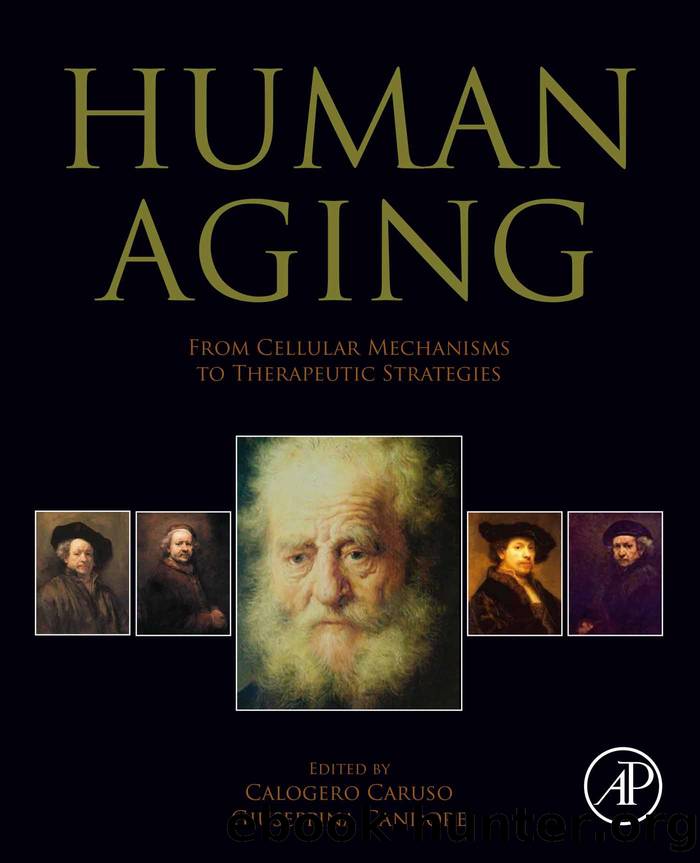Human Aging by Unknown

Author:Unknown
Language: eng
Format: epub
Publisher: Elsevier Science & Technology
Published: 2021-05-11T00:00:00+00:00
10.3.5: Inflammation
Aging is associated with low-grade chronic proinflammatory state that results from an imbalance between the inflammatory and anti-inflammatory networks. Recent years have seen increased interest in the potential role of inflammation in sarcopenia, due also to the fact the numerous inflammatory mediators, collectively known as âmyokines,â are synthesized and secreted by the muscle itself. These locally generated cytokines exert an autocrine function in regulating muscle metabolism, growth, and regeneration, as well as a paracrine/endocrine regulatory function on distant organs (Lee and Jun, 2019). One of the most abundant myokines is myostatin that acts as a negative regulator of muscle growth (White and LeBrasseur, 2014). Supportive evidence for a link between inflammation and sarcopenia comes from epidemiological data, which have shown that higher levels of proinflammatory factors such as interleukin (IL)-6, tumor necrosis factor (TNF)-α), and C-reactive protein (CRP) contribute to the loss of muscle mass and strength that accompanies aging (Visser et al., 2002; Schaap et al., 2009). Elevated IL-6 and TNF-α serum levels were found in older subjects with sarcopenia with respect to control group (Bian et al., 2017). Some studies also evaluated the measures of muscle mass, strength, and function in relation to inflammatory status in hospitalized and community-dwelling older subjects. For instance, Bautmans et al. (2005) proved that patients with inflammation had significantly worse muscle function and that reduced strength and fatigue resistance were significantly related to the levels of CRP, IL-6, and fibrinogen. Furthermore, a relationship was found between increased CRP and reduced grip strength (Norman et al., 2014) and reduced CRP and faster gait speed (Sousa et al., 2016). Similar associations between inflammation markers and muscle mass, strength, and physical performance were observed by Westbury et al. (2018). Possible mechanisms for the associations already mentioned may relate to the combined effects of the multiple age-related impairments caused by inflammation as, for instance, insulin dysregulation, hormonal alteration, endothelial dysfunction, and microvascular changes (Degens, 2010). Moreover, IL-6 and TNF-α at low levels have been shown to induce a transition from proliferation to differentiation of satellite cells; thus, in older individuals, the high levels of these cytokines may affect the maintenance of muscles (Langen et al., 2004; Kurosaka and Machida, 2013). Proinflammatory cytokines also impinge on muscle protein metabolism, with evidence showing that inflammation is associated with reduced rates of protein synthesis paralleled by enhanced protein breakdown (Jo et al., 2012). This likely occurs through different mechanisms, which include activation of the ubiquitin-proteasome system, suppression of the Akt/mTOR pathway, and downregulation of the anabolic effect of IGF-1 (Costamagna et al., 2015).
Download
This site does not store any files on its server. We only index and link to content provided by other sites. Please contact the content providers to delete copyright contents if any and email us, we'll remove relevant links or contents immediately.
They Both Die at the End by Adam Silvera(8611)
Thirteen Reasons Why by Jay Asher(7788)
The Space Between by Michelle L. Teichman(6088)
Suicide Notes by Michael Thomas Ford(4272)
Tuesdays with Morrie by Mitch Albom(3832)
Suicide: A Study in Sociology by Emile Durkheim(2609)
The Checklist Manifesto by Atul Gawande(2203)
Tuesdays With Morrie by Mitch Albom(2172)
Robin by Dave Itzkoff(2005)
In the Woods by Tana French(1996)
Bossypants by Tina Fey(1987)
No Ashes in the Fire by Darnell L Moore(1981)
Reservoir 13 by Jon McGregor(1852)
End of Days by Sylvia Browne(1823)
Olive Kitteridge by Elizabeth Strout(1790)
Bus on Jaffa Road by Mike Kelly(1784)
All Things New by John Eldredge(1781)
Scar Tissue by Anthony Kiedis(1771)
No Time to Say Goodbye(1760)
